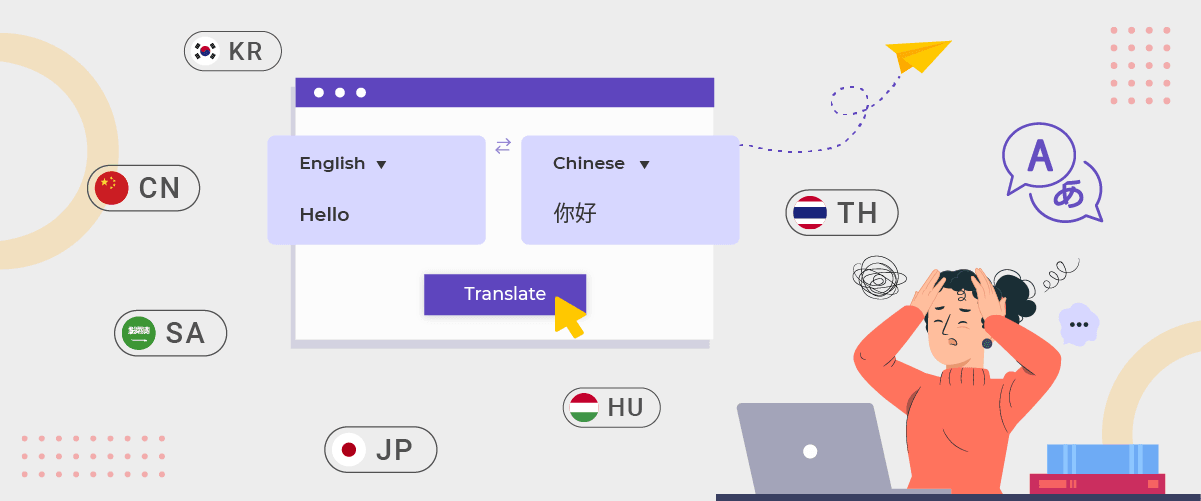Language is a fascinating tool for communication that keeps evolving with time, especially when it comes to reaching out to customers on the worlds with websites. However, translating one language into another can be tricky, and some languages are more challenging to translate than others due to their complexity and unique features. In this blog post, we will discuss the hardest languages to translate and what makes them different from other languages. We will analyze the factors that contribute to translation difficulty, such as vocabulary size, language roots, and grammar rules. We will explore how you can simplify website translation using Linguise, with its user-friendly interface, automatic translation capabilities, and international SEO strategies for search engine success, keep reading!
Factors that make language difficult to translate
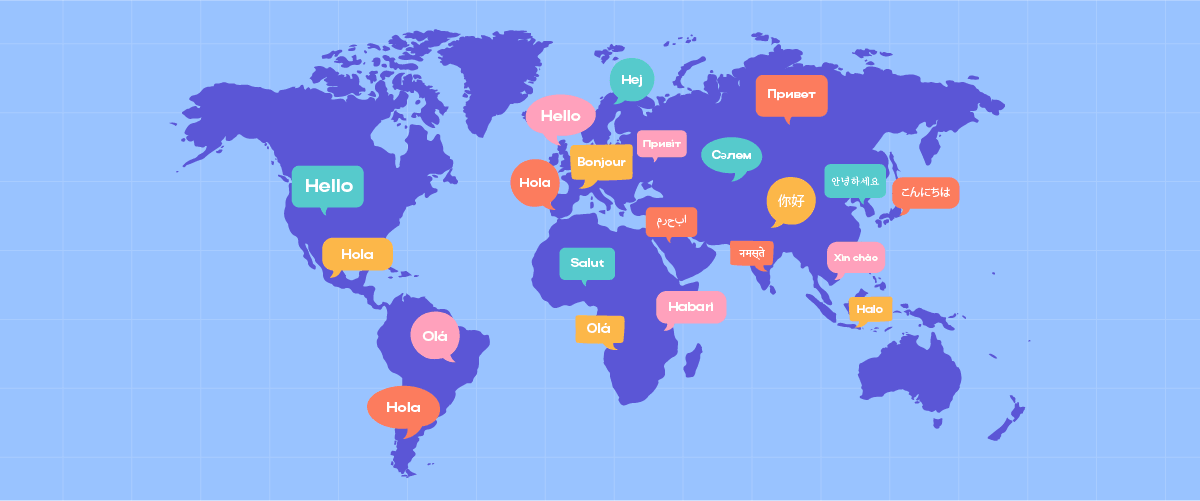
There are around 7,150 different languages spoken worldwide, including the most popular languages; this makes the world of languages incredibly diverse, with each one having its own set of sounds, rules for making sentences, and ways of expressing ideas. It’s only one of the reasons; let’s talk about why it’s made more difficult and complex.
- Complex Vocabulary and Specialized Jargon: Texts filled with technical terms or industry-specific language pose a significant challenge in translation. For instance, legal documents, medical reports, and scientific research papers require the translator to understand the specific terminology used within those fields. This goes beyond mere language proficiency, demanding a comprehensive understanding of the subject matter. Translators often need to conduct extensive research or consult with experts to ensure their translations are accurate and retain the original text’s meaning.
- Cultural Nuances and Idioms: Every language is a reflection of its culture, making idioms, proverbs, and cultural references particularly difficult to translate. These elements often have no direct equivalent in other languages, requiring translators to find creative ways to convey the same sentiment or humor. This challenge underscores the importance of cultural competence in translation, as a literal translation could result in loss of meaning or even misunderstandings. Successful translation of these elements often relies on the translator’s ability to capture the essence of the original text while making it resonate within the cultural context of the target language.
- Differences in Grammar and Syntax: The structural differences between languages can significantly impact the translation process. For example, the order in which subjects, verbs, and objects are placed in a sentence can vary widely across languages. While English typically follows a Subject-Verb-Object (SVO) structure, languages like Japanese use a Subject-Object-Verb (SOV) pattern. Additionally, some languages apply gender to nouns, possess multiple forms for verb conjugations, or use cases to express grammatical relationships, none of which may exist in another language.
Analyzing 10+ hardest languages to translate
Among the most challenging languages to translate, Mandarin Chinese presents a particular challenge due to its unique syntax and characters. Similarly, Korean’s intricate honorifics system and sentence structure make it one of the most difficult languages to render accurately. Arabic, with its own alphabet and lower cases, also presents significant translation hurdles. Additionally, Thai, with its non-Latin script, and Hungarian, unrelated to most other languages, pose significant challenges in translation. These different factors contribute to the complexity of translating these languages for most of the world. Check complete explanation below.
1. Mandarin Chinese
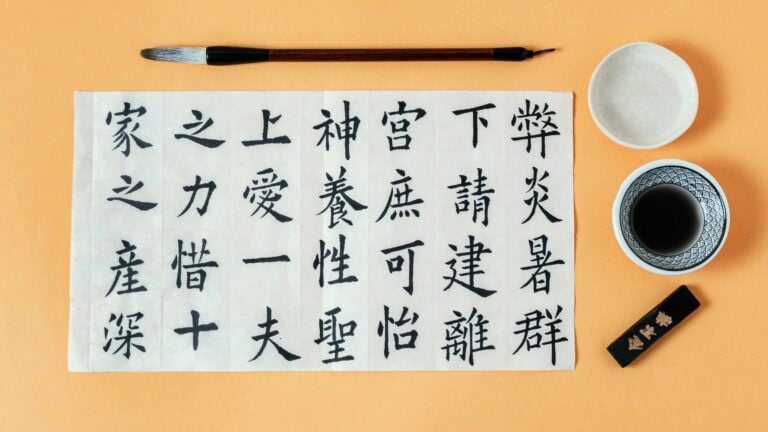
The primary challenge in translating Chinese stems from its vast number of characters, which significantly contributes to the complexity of the language. In contrast to English, which utilizes an alphabet of 26 letters to construct every word in the language, making literacy relatively straightforward once these letters are mastered, Mandarin Chinese presents a far more daunting task. With an estimated range of 50,000 to 80,000 characters, each carrying its own unique meaning and often only subtly differing from others, becomes more complicated.
One significant hurdle is its character-based writing system. Unlike languages that use an alphabet to spell words, each Mandarin character represents a word or a phrase, requiring translators to have a linguistic and cultural grasp to interpret meanings accurately.
We summarize the key challenges in translating Mandarin Chinese, highlighting how each aspect contributes to the difficulty of accurately conveying meanings from Mandarin to other languages.
| Complexity | Description | Example |
|---|---|---|
| Character-based Writing | Each character represents a word or phrase, requiring deep understanding of grammar and context. | The character “光” can mean light, ray, or to shine, depending on its combination with other characters. |
| Tonal Nature | The meaning of a word changes with the tone used to pronounce it. | The syllable “ma” can mean “mother” (mā), “hemp” (má), “horse” (mǎ), or a question marker (ma?) depending on the tone. |
| Dialects and Idioms | Variations in dialects and idioms across regions complicate translation. | “画蛇添足” (literally “to draw a snake and add feet”) means to overdo something or add something superfluous. |
| Grammatical Flexibility | The same word can serve as a noun, verb, or adjective depending on context, making accurate translation tough. | “光” can function as a verb (to shine), a noun (light), or an adjective (bright), based on its use in a sentence. |
2. Korean
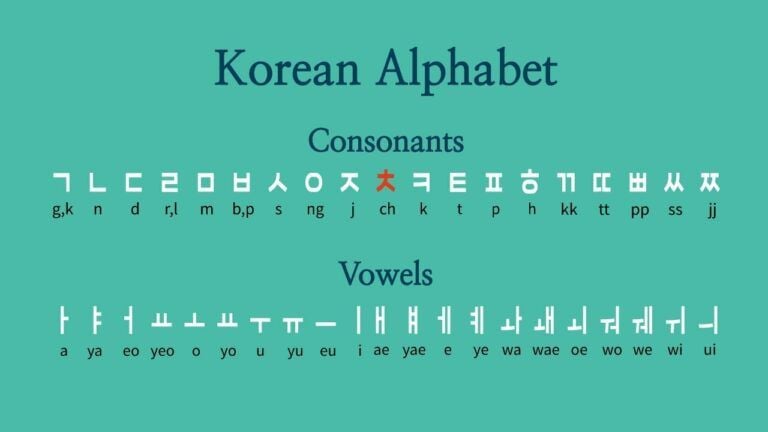
Diving into the complexity of translating Korean reveals a landscape filled with unique hurdles. One of the most notable challenges stems from its exceptional sentence structure and grammar. Korean typically follows a Subject-Object-Verb (SOV) order, unlike the Subject-Verb-Object (SVO) structure in English.
With a rich array of words and expressions, some of which have no direct equivalents in other languages, finding the perfect match for a translation can be daunting. For example, the Korean word “한” (Han) represents a collective feeling of sorrow and resentment, a concept deeply ingrained in Korean culture but hard to convey succinctly in other languages.
Korean is also considered a language isolate, meaning it has no direct linguistic relatives, which adds another layer of difficulty. Its verb conjugations are particularly challenging, as they change based on the level of formality and the relationship between the speaker and the listener. A verb can have multiple forms, and choosing the correct one is crucial for accurate translation.
The language’s vocabulary and idioms, rich with cultural nuances, present further obstacles. Idioms like “개구리 올챙이 적 생각도 못 한다” (literally “The frog forgets its days as a tadpole”) illustrate the challenge as such expressions carry meanings that are deeply cultural and may not translate directly.
These multifaceted challenges collectively make Korean translation a hard task, requiring both linguistic skill and a deep understanding of Korean culture and societal norms to accurately capture the language’s essence in translation.
3. Arabic
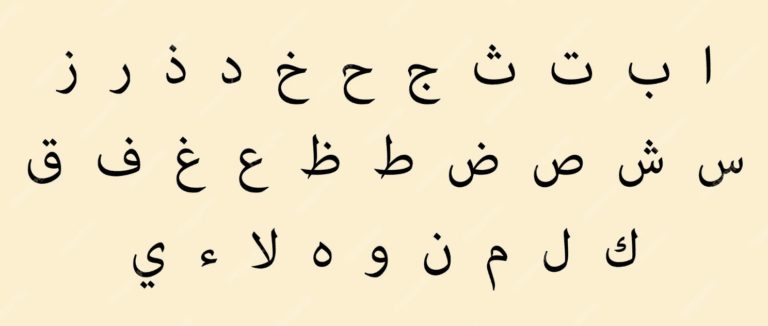
Arabic translation challenges are of its grammar, syntax, and the vast array of dialects. The language’s structure is deeply rooted in a complex system of noun declensions and verb conjugations that significantly differ from those in many Western languages. In Arabic, verbs are conjugated not just for tense but also for gender, number, and aspect, with the verb often coming before the subject in a sentence. This is a marked departure from the syntax of languages like English, where subject-verb-object is the norm.
We summarize the key challenges in translating Arabic, including the complexity of its grammar and syntax, the unique features of the Arabic alphabet, dialectal variations across regions, and the richness of idiomatic expressions. To effectively translate Arabic, a deep understanding of these aspects, along with cultural nuances, is essential.
| Challenge | Description | Example |
|---|---|---|
| Grammar and Syntax | Arabic’s structure involves complex noun declensions and verb conjugations, differing significantly from Western languages. Verbs are conjugated for tense, gender, number, and aspect, often placed before the subject. | Verbs like “كتب” (kataba – he wrote) change form to indicate tense, gender, etc., such as “كتبت” (katabat – she wrote). |
| Arabic Alphabet | The script consists of 28 letters that change form based on their position in a word, read from right to left. | The letter “ب” (bā’) appears as “بـ” at the beginning, “ـبـ” in the middle, “ـب” at the end, and “ب” when standalone. |
| Dialectal Variations | Significant differences in pronunciation, vocabulary, and grammar exist across Arabic-speaking regions. | “How are you?” is “كيف حالك؟” (kayfa ḥālak?) in Modern Standard Arabic but “كيف داير؟” (kayf dāyer?) in Moroccan dialect. |
| Idiomatic Expressions | Rich and abundant idioms often lack direct equivalents in other languages or lose cultural significance when translated literally. | “ضرب عصفورين بحجر واحد” (ḍaraba ‘uṣfūrayn bi-ḥajar wāḥid) means “hitting two birds with one stone.” |
4. Thai
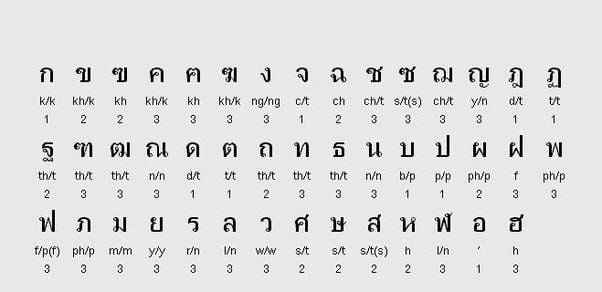
Most of the world recognizes Thai as one of the most challenging languages to translate. Its tonal nature presents different ways of articulating words, making it challenging for non-native speakers.
The complex script consisting of 44 consonants and 32 vowels adds another layer of difficulty. The language’s formal and informal registers and absence of articles and plurals pose significant challenges for translators. Translating Thai becomes demanding when combined with the intricate grammar system and idiomatic expressions.
Here’s a closer look at these complexities with examples:
- Tonal Nature: Thai is a tonal language, meaning the tone in which a word is spoken can change its meaning entirely. For instance, the word “mai” can mean “new” (ใหม่) with a high tone, “not” (ไม่) with a falling tone, “wood” (ไม้) with a mid tone, or can be used as a question marker (ไหม) with a rising tone. This tonal complexity requires precise articulation and understanding to ensure accurate translation.
- Complex Script: The Thai script is intricate, with 44 consonants and 32 vowels that combine in various ways to form characters. This complexity is compounded by the fact that Thai writing does not use spaces between words, making sentence segmentation challenging for non-native speakers and translators. For example, the character for “k” (ก) can look very different when combined with different vowels, and understanding its use in various contexts is crucial for accurate translation.
- Formal and Informal Registers: Thai language employs different registers for formal and informal communication, which can affect word choice, sentence structure, and politeness levels. The formal register might use the word “พระ” (pra) as a prefix for royal and religious figures, while informal speech uses more colloquial expressions. This requires translators to be adept at switching between registers based on the context and audience of the text.
- Grammar System and Idiomatic Expressions: Thai grammar does not rely on articles, plurals, or verb conjugations like many Indo-European languages do. Additionally, idiomatic expressions are deeply rooted in Thai culture and history. An expression like “หมาไม่กินหมา” (mā mâi gin mā), literally “a dog doesn’t eat dog,” reflecting the idea of professional courtesy, illustrates the challenge of translating idioms that may lack direct equivalents in other languages.
5. Hungarian
Hungarian, considered one of the most difficult languages to translate, presents a challenge with its complex grammar rules and 35 different cases. The language’s vocabulary adds to the complexity, as words often have multiple meanings and nuances. Achieving accurate Hungarian translations requires an understanding of its cultural context and history. Despite these difficulties, professional translators can skillfully navigate Hungarian’s intricacies, providing accurate and culturally sensitive translations.
Here’s an elaboration with examples in a table format:
| Challenge | Description | Example |
|---|---|---|
| Complex Grammar | Hungarian grammar is known for its complexity, including the extensive use of prefixes and suffixes. | The use of “meg-” as a prefix can change the meaning of a verb, e.g., “ír” (write) to “megír” (to write up/complete writing). |
| 35 Different Cases | Hungarian uses 35 cases, affecting the endings of nouns depending on their role in the sentence. | In the accusative case, “kutya” (dog) becomes “kutyát” to indicate the object of an action. |
| Rich Vocabulary | Words in Hungarian can have multiple meanings and nuances, influenced by context. | “Szár” can mean “dry” or “stem,” depending on the context. |
| Cultural Context | Understanding Hungarian requires knowledge of its cultural context and history. | Idioms like “Kettesben jobb a baj” (Trouble is better in pairs) reflect Hungarian cultural nuances. |
6. Japan
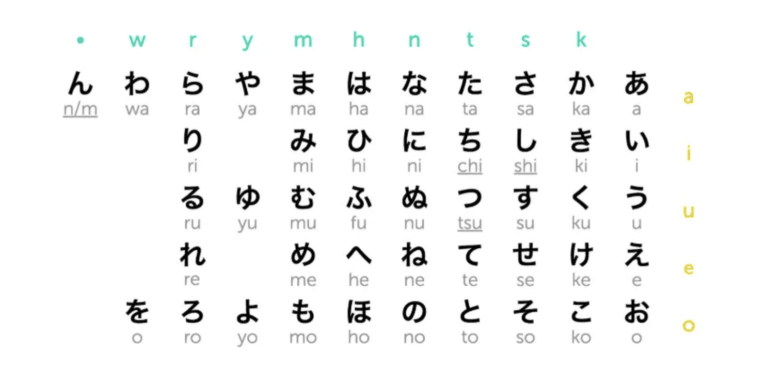
The Japanese language presents unique challenges for translation. With three different scripts, including kanji, katakana, and hiragana, translating Japanese requires an understanding of various writing systems. The use of honorifics and context-dependent meanings adds complexity.
The subject-object-verb word order and multiple homophones further contribute to the difficulty. To accurately translate Japanese, professional translators must deeply understand the culture. These different factors make Japanese one of the most challenging languages to translate, requiring expertise beyond just linguistic proficiency.
Multiple Scripts: Japanese utilizes kanji, katakana, and hiragana, each serving distinct roles. For example, kanji are used for most nouns and the root of verbs and adjectives, hiragana for grammatical elements, and katakana for foreign loanwords and emphasis.
Honorifics: The language incorporates various levels of formality and respect, affecting verb forms and vocabulary. A simple verb like “desu” (to be) can become more formal as “de gozaimasu,” reflecting the nuanced levels of politeness.
Context-Dependent Meanings: Japanese heavily relies on context, where words or phrases may have multiple meanings. The verb “taberu” (to eat) requires contextual clues to fully understand who is eating, what is being eaten, and the politeness level.
Word Order: The typical sentence structure follows a subject-object-verb (SOV) order, unlike the subject-verb-object (SVO) structure in English. This requires rearrangement in translation, such as turning “I eat an apple” into “Watashi wa ringo o tabemasu” (literally, “I apple eat”).
Homophones: Japanese has a significant number of homophones, making accurate translation challenging without clear context. The word “hashi” can mean either “bridge” or “chopsticks,” depending on the kanji used and the surrounding context.
7. Finnish
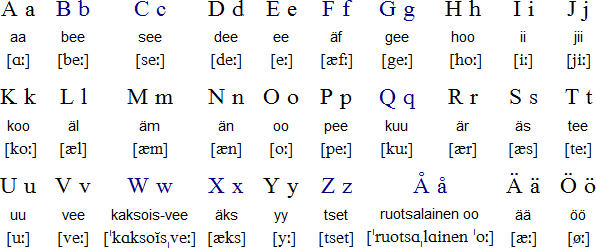
Finnish is considered one of the most difficult languages to translate in the world due to its complex grammar, pronunciation that differs from its written form, and everyday language filled with local expressions. This language originates from the Uralic language family, one of the smallest language families in the world, making its structure very unique.
Finnish is also rich in vocabulary sourced from languages such as Arabic, German, French, and English. However, many of these borrowed words have meanings and uses that are different from those of their original languages, so translators need to understand the local context to produce accurate translations.
Challenge | Description | Example |
No Future Tense | Finnish grammar lacks a future tense, so translators must interpret context carefully. | “Huomenna menen kouluun” (Tomorrow I go to school) literally translates to “I go to school tomorrow” in the present tense. |
Grammar Complexity | 15 grammatical cases with different inflexions for verbs and nouns based on sentence function. | “Talo” (house) changes to “talossa” (in the house). |
Spoken vs. Written | Everyday speech often uses informal expressions that differ from standard grammar. | “Mä meen kouluun” (I go to school) is the informal form of “Minä menen kouluun.” |
8. Hebrew
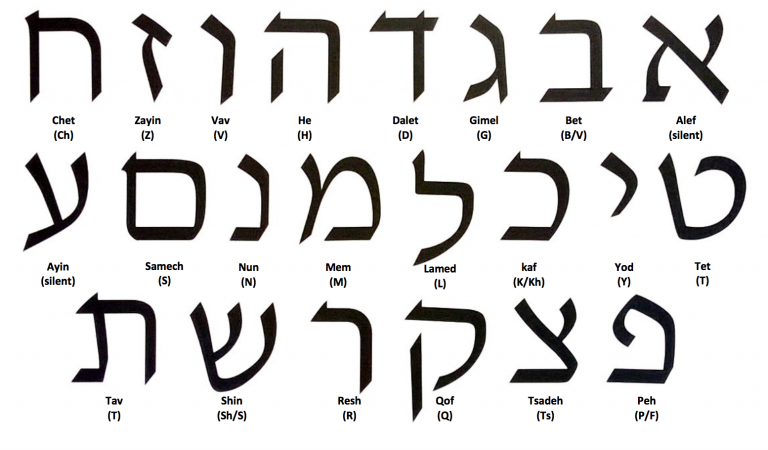
Next is Hebrew. Hebrew words often come from three-letter roots, to which various prefixes, suffixes and vowel patterns are added to form new meanings. Translators must understand the context very well to choose the right form.
Not only that, many Hebrew words have multiple meanings depending on the context, thus requiring in-depth knowledge to ensure an appropriate translation.
The language also has unique grammatical structures, including complex plural and gender patterns. For example, many nouns have masculine and feminine forms that must be matched with the corresponding adjective or verb.
Challenge | Description | Example |
Root-based Structure | Words are derived from three-letter roots, and vowel patterns along with prefixes/suffixes change the meaning. | The root “k-t-b” produces “koteb” (writing), “mikhtav” (letter). |
Gender Complexity | Many words have masculine and feminine forms that affect sentence structure. | “Yeladim” (children, masculine) vs. “Yeladot” (children, feminine). |
Lack of Vowels in Writing | Hebrew is typically written without vowels, requiring readers to infer the correct pronunciation from context. | “כתב” (ktb) could mean “to write” (k-t-b) or “writings” (k-t-b). |
9. Mongolian
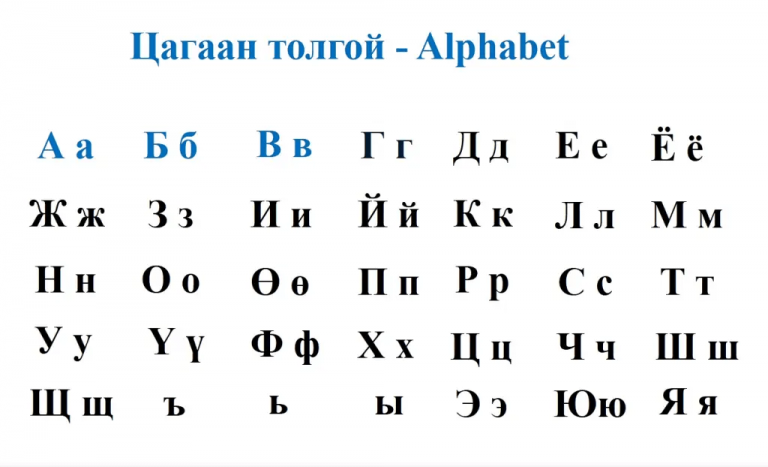
Mongolian is a complex language influenced by Chinese, Russian, and Finnish. It uses the Cyrillic alphabet, which was introduced in the 1940s, although historically, it used a vertical script. This language’s complexity stems from its historical ties to the Mongol Empire, which incorporated various linguistic influences.
For English speakers, Mongolian is challenging due to its unique phonetics, sentence structure, and vocabulary, which differ greatly from Indo-European languages. The blend of Chinese, Russian, and Finnish elements, combined with the Cyrillic script, makes it particularly difficult for Europeans to learn.
Challenge | Description | Example |
Complex Phonetics | Mongolian has sounds that are not found in English, making pronunciation difficult for non-native speakers. | “Тархи” (tarkhi), meaning “brain” has a distinct sound compared to English. |
Mixed Language Influences | A blend of Chinese, Russian, and Finnish influences makes Mongolian unique and complex to understand. | “Зарим” (zarim), meaning “some” has Russian roots but is used uniquely in Mongolian. |
Cyrillic Alphabet | The use of Cyrillic, combined with additional characters, adds complexity for those not familiar with it. | “Сайн уу?” (Sain uu?) meaning “Hello?” uses the Cyrillic alphabet with Mongolian characters. |
10. Polish
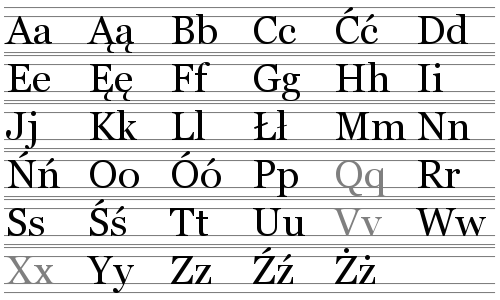
Polish, an Indo-European language, is notorious for its 14 declensions, complex gender system, and flexible word order. Unlike English, which relies on a fixed subject-verb-object structure, Polish allows words to be arranged in almost any order, demanding context awareness. Pronunciation also poses a significant challenge, with consonant clusters like Szcz being a hallmark of Polish complexity.
The expansive vocabulary further complicates learning, as simple terms like “two” can have 22 variations depending on grammatical context. Despite its difficulty, mastering Polish provides deep access to Slavic culture and history, which makes the effort worthwhile for those dedicated to learning it.
Challenge | Description | Example |
14 Declensions | Words change forms based on their grammatical role in a sentence. | “Dom” (house), “domu,” “domem.” |
Free Word Order | Flexible sentence construction with no fixed structure. | “I read a book” can be “Książkę czytam” or “Czytam książkę.” |
Pronunciation Challenges | Complex consonant clusters make words hard to pronounce. | “Szczęście” (happiness). |
11. Icelandic
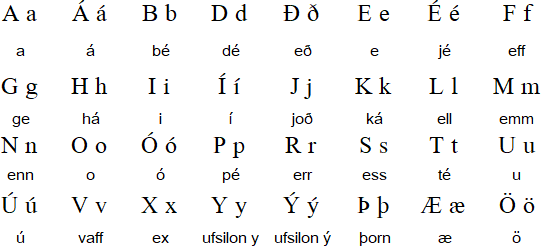
Icelandic is among the hardest languages to learn. Fewer than 400,000 people have spoken it, and it has remained nearly unchanged since the 9th century. Its roots in Old Norse and a deliberate preservation of linguistic purity make it a unique yet challenging language. The Icelandic Language Committee actively creates new words rather than adopting foreign terms, making vocabulary expansion daunting for learners.
The grammar system adds another layer of difficulty with its complex inflections, gendered nouns, and four grammatical cases. Although Icelandic shares some Germanic pronunciation systems, its unique rules demand significant effort from learners. Furthermore, minimal exposure to loanwords and unfamiliar structures make Icelandic inaccessible to most non-native speakers.
Challenge | Description | Example |
Invented Words | New words are coined frequently, creating a rapidly growing vocabulary. | “Tölva” (computer) was invented by combining “number” and “prophet.” |
Minimal Loanwords | Very few borrowed words, making it harder to find familiar terms. | “Bíll” (car) is unique to Icelandic compared to English “car.” |
Complex Grammar | Four grammatical cases and gendered nouns make usage intricate. | Noun declensions vary: “maður” (man), “manns,” “manni,” “mann.” |
Simplifying website translation, despite the difficulties of language barriers
Translating languages is often a complex task, influenced by various factors. However, when it comes to making your website multilingual, Linguise streamlines the process, making it both faster and more flexible.
With its high-quality translations, user-friendly interface, and convenient editing tools for translators, as well as the capability to translate text within images, your website can reach a global audience, breaking down language barriers.
By leveraging these advanced features, the translation process becomes simpler, enabling your website to be accessible to a broader audience and enhancing its global appeal. This approach not only improves user experience but also significantly expands your site’s potential reach, opening up new markets and opportunities.
Live editor with user-friendly interface
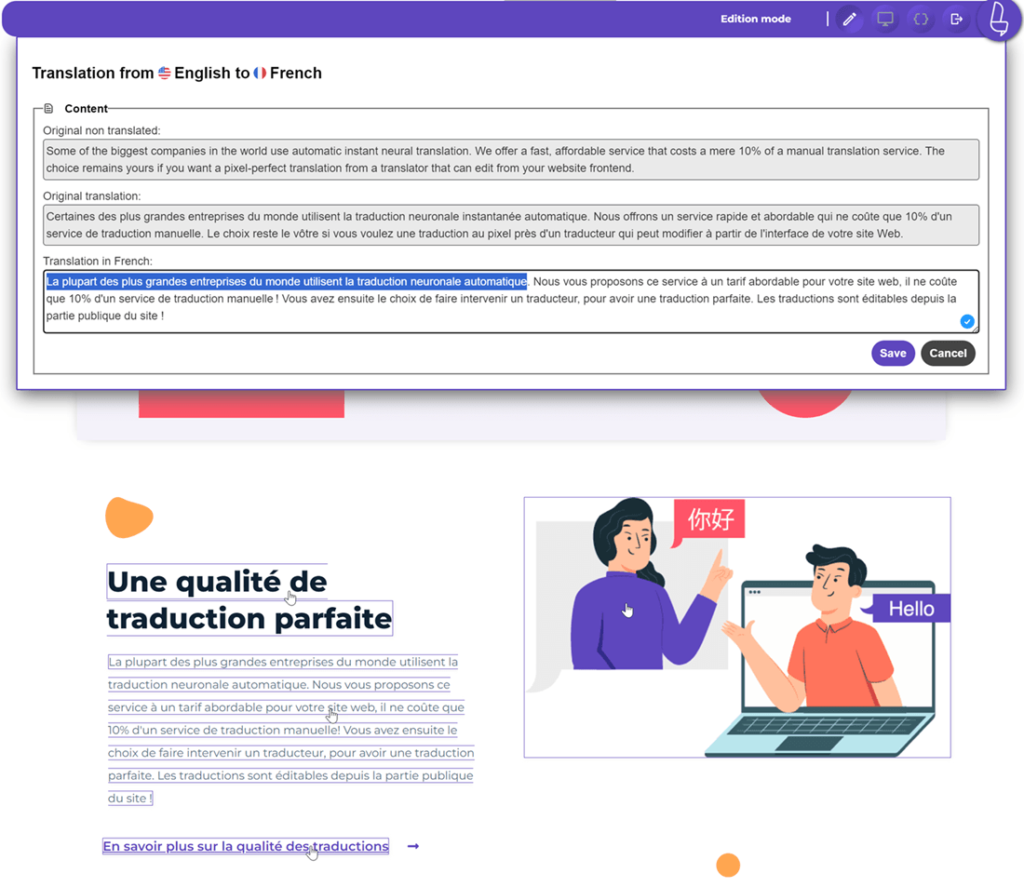
The “live editor” feature is a powerful tool that significantly enhances the translation process on your website. After the initial translation is completed by the automated translation, this feature allows you to directly make edits and fine-tune translations on the front end of your website. This capability ensures that you can swiftly adjust any part of the translation to better reflect nuances, correct any inaccuracies, or simply improve the flow of the text as it appears to the end user.
Working with the live editor, you’re able to see changes in real time within the context of your website’s design and layout. This immediate feedback loop is invaluable for achieving more accurate and natural-sounding translations.
Support more than 80 languages and thousands of language pairs
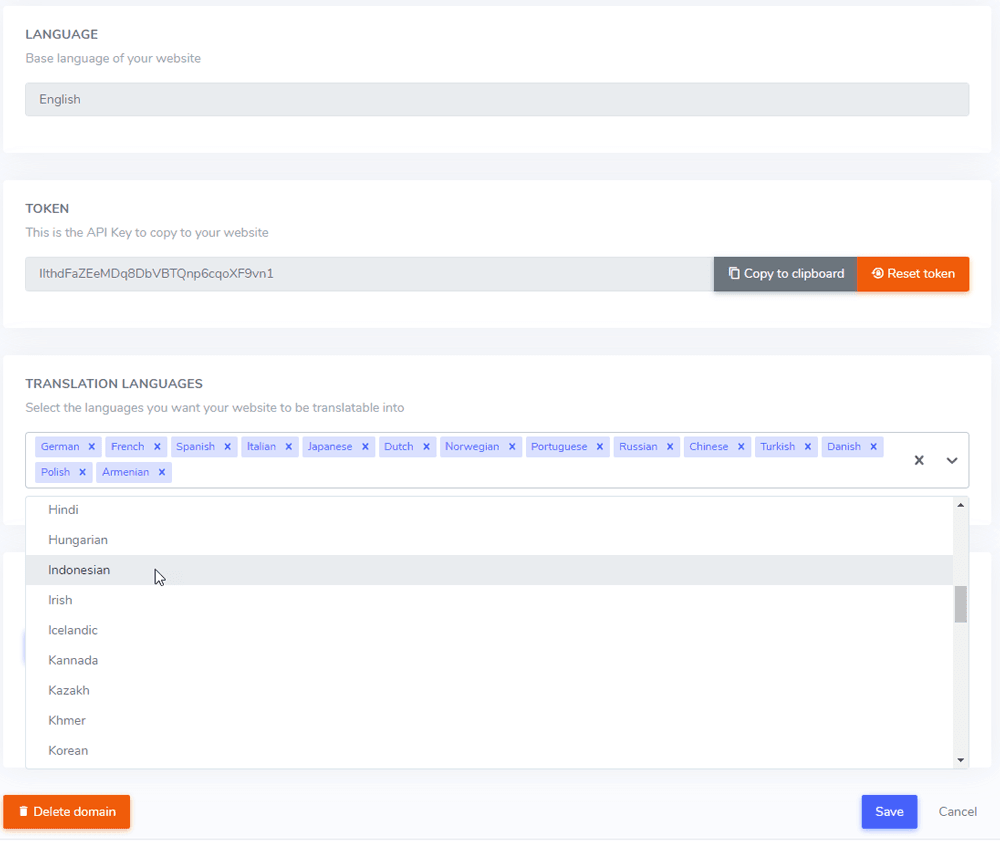
Linguise offers an expansive range of more than 80 languages, encompassing thousands of possible language pairs. This wide selection means that whether you’re looking to translate your content from or into lesser-known traditional languages or the most widely spoken languages globally, Linguise has you covered.
This extensive language support ensures that virtually any website can become truly global, breaking down linguistic barriers that might otherwise limit its reach. For instance, a website originally in English can be translated into various languages, from major ones like translating Spanish, Chinese language, translating Arabic and Japan to less commonly spoken languages such as Swahili or Icelandic, thus catering to a diverse audience.
This capability is particularly beneficial for websites targeting multilingual regions or global audiences, ensuring that content is accessible and relevant to users in their native language.
Exclude translation
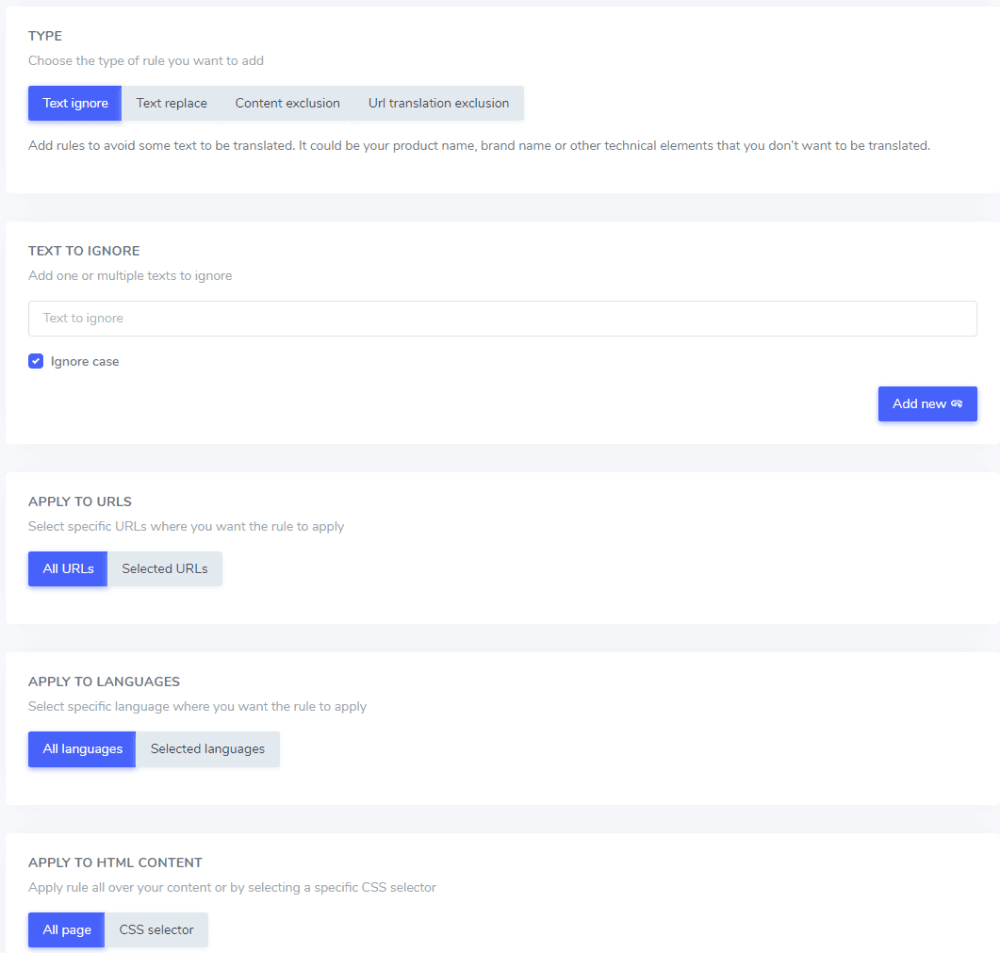
Linguise goes beyond basic translation capabilities by offering an advanced feature that allows users to exclude specific text from being translated according to customizable rules. Useful for preserving the integrity of technical phrases, brand names, or any other terminology that should remain unchanged across different language versions of your website. By setting up rules to exclude specific text, you ensure that these elements retain their original form, maintaining consistency and brand identity regardless of the viewer’s language.
If your website mentions a proprietary technology or product name that should not be translated, you can specify these terms in Linguise’s exclusion rules. This ensures that when the rest of the content is translated into another language, these specific terms will remain in the default language, untouched by the translation process. It’s a way of telling Linguise, “Translate everything except for these specific terms.”
This feature enhances the flexibility and accuracy of machine translation by combining the best of automated technology with the precision of manual editing.
Ready to translate hardest language with Linguise?
Translating languages can be a complex process, influenced by various factors such as language roots, vocabulary size, and unique challenges. Mandarin Chinese, Korean, Arabic, Thai, Hungarian, Japanese are among the hardest languages to translate due to their intricacies and nuances. However, it is important to note that there is no definitive “hardest language” as translation difficulties can vary depending on individual experiences and expertise. But when it comes to translating your website, there are tools available to simplify the process, including user-friendly interfaces, image translation capabilities, automatic translation, and multilingual SEO. By using right resources, you can overcome the challenges of language translation and effectively reach a global audience
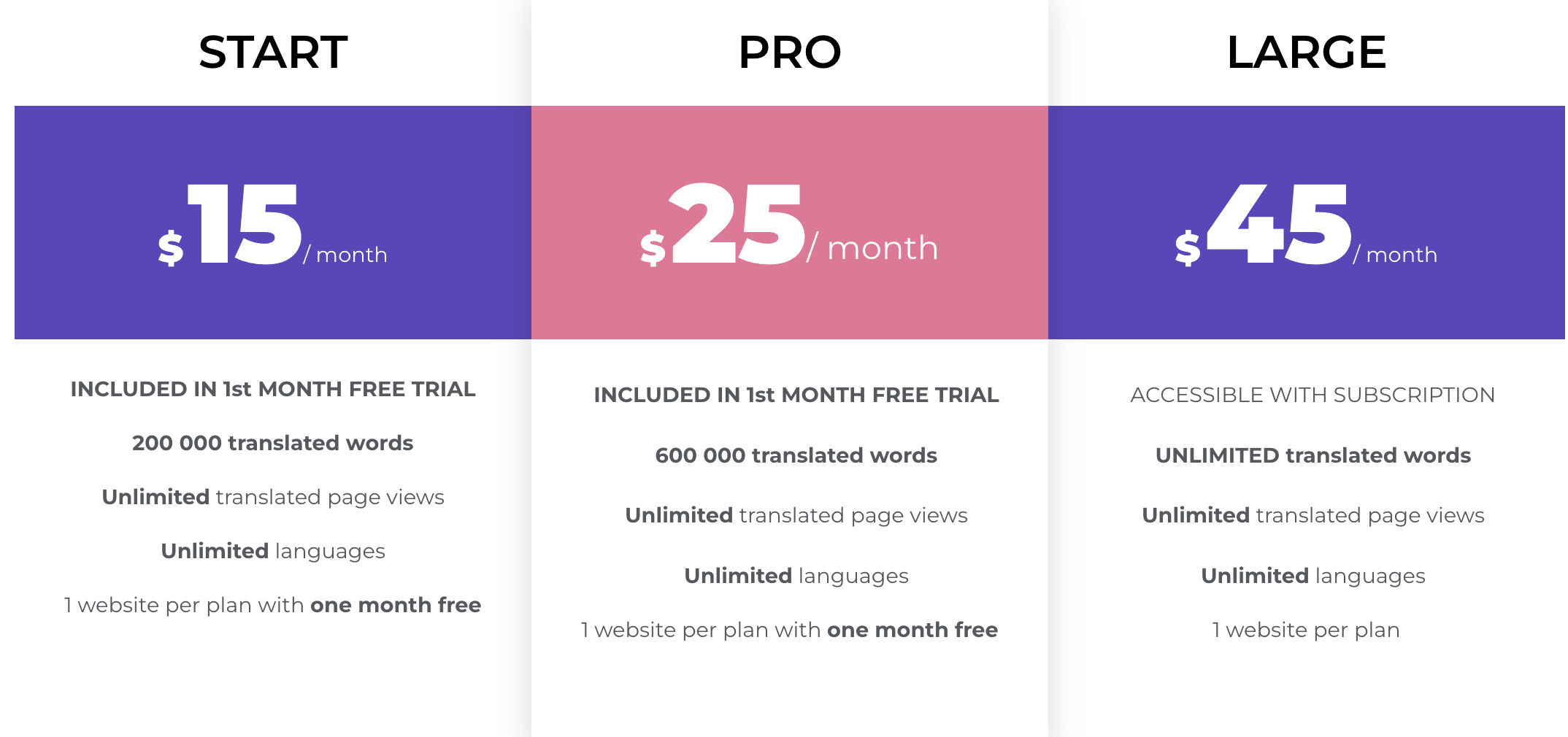
You can try Linguise with trial, this trial available for 30 days, comes packed with compelling features including the ability to translate in an unlimited number of languages, cover up to 600,000 words, among other advantages.
Once the trial period end, you have the option to subscribe starting from $15 per month. This subscription allows your website to embrace translations in up to 85 languages while also receiving full SEO support.
Register a Linguise account for free for 1 month, and localize the site by translating up to 600 thousand words!

